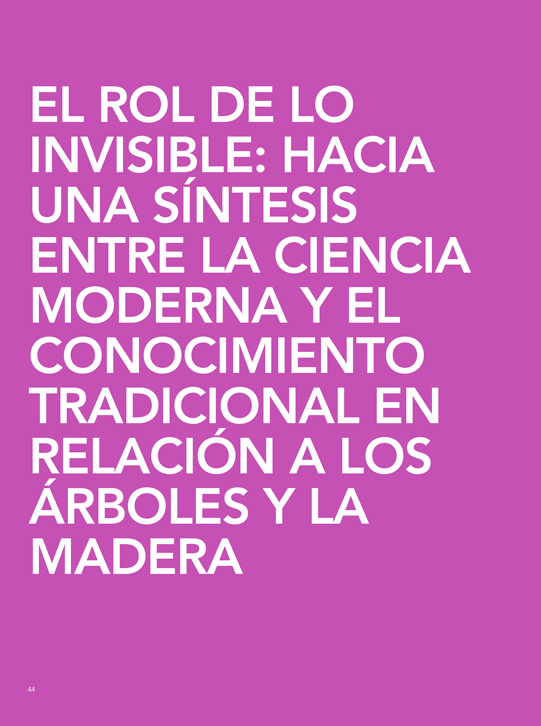El rol de lo invisible: Hacia una síntesis entre la ciencia moderna y el conocimiento tradicional en relación a los árboles y la madera
Article Sidebar

Keywords:
Main Article Content
Abstract
El análisis y la experimentación del proceso de generación del conocimiento revelan que lo invisible es una parte constitutiva de nuestra realidad. Este hecho contribuye a relativizar nuestra actual visión materialista del mundo moderno, ofreciendo un puente hacia una mejor comprensión de las cosmovisiones holísticas tradicionales y el conocimiento práctico basado en ellas. Se entregan ejemplos de diferentes dominios relacionados con los árboles y la madera: espiritualidad relacionada con la naturaleza, anatomía, principios estructurales, cronobiología, ritmos lunares y propiedades de la madera, mensajes sutiles y fertilidad del suelo. Un enfoque como este tiene el poder de producir nuevas sinergias entre tradición y modernidad y propone soluciones para regenerar el mundo en un tiempo de transformación global.
Article Details
Materia Arquitectura provides immediate and free access to all the content of this online edition, published simultaneously with the print edition.
Materia Arquitectura does not charge authors for any concept.
All contents of this electronic edition are distributed under the Creative Commons license of "Attribución-shareAlike 4.0 Internacional" (CC-BY-SA).
The rights of the published texts and images belong to their authors, who grant Materia Arquitectura the license for their use. The management of the permits and the authorization of the publication of the images (or of any material) that contains copyright and its consequent rights of reproduction in this publication is the sole responsibility of the authors of the articles.
As long as they mention their origin, the authors are free to distribute their articles by other means. Any total or partial reproduction of the material must mention its origin.
Downloads
References
FESCHOTTE, P. (1990). Les mirages de la science. Chatou, Francia: Les Trois Arches.
HUGO, V. (1856/1911). Ce que dit la bouche d’ombre. En V. Hugo, Les Contemplations (pp. 438-463). París, Francia: Nelson.
KREYENBÜHL, J. (1885/2008). Die Bedeutung der Philosophie fu?r die Erfahrungswissenschaften. En M. Rist (Ed.), Johannes Kreyenbu?hl. Aus seinem
Leben und Werk (pp. 57-72) Dornach, Suiza: Johannes Kreyenbu?hl Akademie.
LACOSTE, J. (1992). La métamorphose des plantes. Littérature, 86(2), 72-84.
PIQUE, P. (2013). L’arbre visionnaire. En P. Capelle, & M. Boccara, Voyage entre ciel et terre: Sociomytho-logies de l’arbre (pp. 185-241). Agnières, Francia: Editions Le Temps Présent; Le Musée de l’Invisible.
STEINER, R. (1892/1982). Vérité et science: Prologue à une philosophie de la liberté. Ginebra, Suiza: Anthroposophiques Romandes.
STEINER, R. (1894/1983). La Philosophie de la Liberté: Observations de l’âme conduites selon la méthode scientifique. Ginebra, Suiza: Anthroposophiques Romandes.
ZÜRCHER, E. (2016). Die Bäume und das Unsichtbare: Erstaunliche Erkenntnisse aus der Forschung. Aarau, Suiza: AT.
Most read articles by the same author(s)
- Ernst Zürcher, The role of the Invisible: Towards a synthesis between modern science and traditional knowledge in relation with trees and wood , Materia Arquitectura: No. 15 (2017): Materia Arquitectura 15 (Agosto/August 2017)